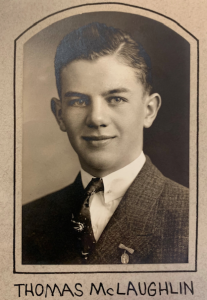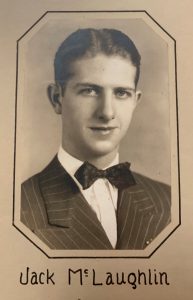By David E. Schroeder
Special to NKyTribune
Part 2 of a continuing series on the 75th anniversary of the closing stages of World War II; for Part 1, click here.
The anniversary of D-Day and recent Memorial Day ceremonies sparked my interest in looking at the stories of the men and women who gave the supreme sacrifice in World War II. As is my pattern, I turned toward my Ludlow, Kentucky roots. I knew that nearly 900 Ludlow residents served in the armed forces during the war, and that 27 never returned home. However, I knew very little about their lives and service histories. I started digging and found several stories that needed to be told: Charles I. Garrett and brothers Thomas and John McLaughlin.

Ludlow Kentucky War Memorial (Photo provided)
In 1940, Charles I. Garrett was living at 37 Kenner Street in Ludlow with his parents Albert and Smittie Garrett and his sister Virginia. Garrett was born in Kentucky and attended Ludlow schools. His father worked as a baggage handler for the Southern Railroad. Charles graduated from Western Kentucky State Teachers College in 1938 and was a member of the United States Army Reserves, reaching the rank of 2nd Lieutenant.
Like many men of his era, his life changed dramatically when he was called to active duty at the age of 25 in August 1940. At that time, he was raised in rank to 1st Lieutenant and eventually Captain. Garrett was assigned to the 31st Infantry Regiment in the Pacific and sent to the Philippine Islands. Here he took part in the Battle of Corregidor (May 5–6, 1942). On March 14, 1943, his family was informed in a telegraph by the United States War Department that he had been captured by the Japanese Army and was being held in the Philippines War Camp No. 1.
Garrett remained a prisoner of war in the Philippines for two and a half years. Japanese prison camps were known for their brutality.

Prisoners of war were often worked to death and were provided with very little food. During the war, it is estimated that 25,600 American prisoners of war were held in the Pacific by the Japanese – 10,650, or nearly 45%, died while imprisoned.
Many succumbed to starvation and disease.
In 1944 American troops made their final push to retake the Philippines. Help was on the way. However, the Japanese Army made a decision to transport prisoners like Garrett to Japan to be used as slave laborers. Garrett was loaded on a Japanese freighter named the Arisan Maura. They set sail for Japan in a convoy of 13 ships marked as merchant vessels. Three Japanese destroyers acted as escorts. As American submarines approached the convoy, the Japanese vessels were ordered to break formation and head to Japan as quickly as possible.
The Arisan Maura was a relatively slow ship and quickly fell behind. On October 24, 1944, the ship was torpedoed by an American submarine that mistakenly identified it as a merchant vessel. The ship carried 1,781 prisoners of war including Garrett. It was reported that all of the prisoners survived the initial attack, however, the Japanese did nothing to rescue them. In all, only nine survived. Garrett was not one of the survivors. He is listed in official records as being executed while trying to escape.
His parents were eventually notified of his death. However, his body was not recovered. Garrett was posthumously awarded the bronze star and purple heart for his heroism. He is recognized on the Tablets of the Missing at the Manila American Cemetery in the Philippines and at the Ludlow, Kentucky War Memorial.

The McLaughlin brothers, Anthony Thomas and John “Jack,” also left behind a story of heroism. Anthony Thomas McLaughlin was born in 1920 and John “Jack” in 1923. They were the sons of Thomas and Helen Scott McLaughlin. The brothers attended St. James Elementary and High School in Ludlow. Their father was employed by the Southern Railroad and was president of the Old Kentucky Switchmen’s Union No. 214. The family lived at different times on Elm and Butler Streets. Thomas McLaughlin died in 1940, leaving his two sons and widow as survivors.
Before the war, Anthony Thomas McLaughlin earned a two-year college degree and was working as an underwriter for the American Automobile Insurance Company. He enlisted In the United States Marine Corps in June 1942 and eventually earned the rank of Sergeant. He was sent to the Pacific theater and assigned to a flying unit. In May 1944, his mother was informed that her son had been shot down over the Pacific and was listed as missing in action. His body was never recovered, and he is listed on the Court of the Missing Monument in Honolulu with a date of death as May 4, 1944. At the time of his death, McLaughlin had been engaged to Genevieve Marr of Dayton, Kentucky.
The younger McLaughlin brother, John “Jack,” also joined the Marines in 1943, reaching the rank of Corporal. Like his older brother, John was sent to the Pacific. He took part in the Battle of Okinawa (April 1-June 22, 1945), one of the bloodiest campaigns of the war resulting in 12,500 Americans missing and dead. John McLaughlin was counted among the dead. His mother received a telegram on June 1, notifying her that her only remaining child was dead at the age of 21. He was laid to rest in the National Cemetery in Honolulu. At the time of his death, John was engaged to Mary Catherine Glueck of Ludlow. McLaughlin’s mother, Helen, died in 1952 in Cincinnati at the age of 57.
Both brothers are also remembered on the Ludlow, Kentucky War Memorial.
More than 415,000 Americans died in World War II. These are three stories from one small river town in Kentucky.
David E. Schroeder is Director of the Kenton County Public Library. He is the author of Life Along the Ohio: A Sesquicentennial History of Ludlow, Kentucky (2014), coeditor of Gateway City: Covington, Kentucky, 1815-2015 (2015), and coauthor of Lost Northern Kentucky (2018).
























